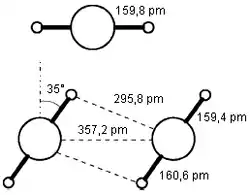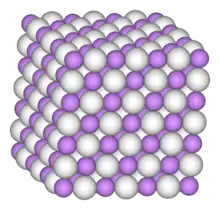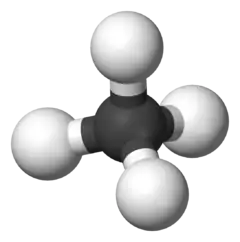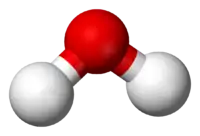Mercury(II) hydride
Mercury(II) hydride (systematically named mercurane(2) and dihydridomercury) is an inorganic compound with the chemical formula HgH
2 (also written as [HgH
2]). It is both thermodynamically and kinetically unstable at ambient temperature, and as such, little is known about its bulk properties. However, it known as a white, crystalline solid, which is kinetically stable at temperatures below −125 °C (−193 °F), which was synthesised for the first time in 1951.[1]
 | |
| Names | |
|---|---|
| IUPAC name
Mercury(II) hydride | |
| Other names
Mercurane Mercuric hydride | |
| Identifiers | |
3D model (JSmol) |
|
PubChem CID |
|
| |
| |
| Properties | |
| HgH 2 | |
| Molar mass | 202.61 g mol−1 |
| Related compounds | |
Related compounds |
Zinc hydride |
Except where otherwise noted, data are given for materials in their standard state (at 25 °C [77 °F], 100 kPa). | |
| Infobox references | |
Mercury(II) hydride is the second simplest mercury hydride (after mercury(I) hydride). Due to its instability, it has no practical industrial uses. However, in analytical chemistry, mercury(II) hydride is fundamental to certain forms of spectrometric techniques used to determine mercury content. In addition, it is investigated for its effect on high sensitivity isotope-ratio mass spectrometry methods that involve mercury, such as MC-ICP-MS, when used to compare thallium to mercury.[2]
Properties
Structure
In solid mercury(II) hydride, the HgH2 molecules are connected by mercurophilic bonds. Trimers and a lesser proportion of dimers are detected in the vapour. Unlike solid zinc(II), and cadmium(II) hydride, which are network solids, solid mercury(II) hydride is a covalently bound molecular solid. This is due to relativistic effects, which also accounts for the relatively low decomposition temperature of -125 °C.[3]
The HgH2 molecule is linear and symmetric in the form H-Hg-H. The bond length is 1.646543 Å. The antisymmetric stretching frequency, ν3 of the bond is 1912.8 cm−1, 57.34473 THz for isotopes 202Hg and 1H.[3] The energy needed to break the Hg-H bond in HgH2 is 70 kcal/mol. The second bond in the resulting HgH is much weaker only needing 8.6 kcal/mol to break. Reacting two hydrogen atoms releases 103.3 kcal/mol, and so HgH2 formation from hydrogen molecules and Hg gas is endothermic at 24.2 kcal/mol.[3]
Biochemistry
Alireza Shayesteh et al conjectured that bacteria, containing the flavoprotein, mercuric reductase, such as Escherichia coli, can in theory reduce soluble mercury compounds to volatile HgH2, which should have a transient existence in nature.
Production
Mercury(II) chloride reduction
Mercury(II) hydride may be prepared by the reduction of mercury(II) chloride. In this process, mercury(II) chloride and a hydride salt equivalent react to produce mercury(II) hydride according to the following equations, which depend on the stochiometry of the reaction:
- 2 HgCl
2 + 2 H−
→ HgCl2−
4 + HgH
2 - HgCl
2 + 2 H−
→ HgH
2 + 2 Cl−
Variations of this method exits where mercury(II) chloride is substituted for its heavier halide homologues.
Direct synthesis
Mercury(II) hydride can also be generated by direct synthesis from the elements in the gas phase or in cryogenic inert gas martices:[3]
- Hg → Hg*
- Hg* + H
2 → [HgH
2]* - [HgH
2]* → HgH
2
This requires excitation of the mercury atom to the 1P or 3P state, as atomic mercury in its ground-state does not insert into the dihydrogen bond.[3] Excitation is accomplished by means of an ultraviolet-laser,[1] or electric discharge.[3] The initial yield is high; however, due to the product being in an excited state, a significant amount dissociates rapidly into mercury(I) hydride, then back into the initial reagents:
- [HgH
2]* → HgH + H - HgH → Hg + H
- 2 H → H
2
This is the preferred method for matrix isolation research. Besides mercury(II) hydride, it also produces other mercury hydrides in lesser quantities, such as the mercury(I) hydrides (HgH and Hg2H2).
Reactions
Unpon treatment with a Lewis base, mercury(II) hydride coverts to an adduct. Upon treatment with a standard acid, mercury(II) hydride and its adducts convert either to a mercury salt or a mercuran(2)yl derivative and elemental hydrogen. Oxidation of mercury(II) hydride gives elemental mercury. Unless cooled below −125 °C (−193 °F), mercury(II) hydride decomposes to produce elemental mercury and hydrogen:[4]
- HgH
2 → Hg + H2
History
Mercury(II) hydride was successfully synthesized and identified in 1951 by Egon Wiberg and Walter Henle, by the reaction of mercury(II) iodide and lithium tetrahydroaluminate in a mixture of petroleum ether and tetrahydrofuran. In 1993 Legay-Sommaire announced HgH2 production in cryogenic argon and krypton matrices with a KrF laser.[1] In 2004, solid HgH2 was definitively synthesized and consequentially analysed, by Xuefeng Wang and Lester Andrews, by direct matrix isolation reaction of excited mercury with molecular hydrogen.[4] In 2005, gaseous HgH2 was synthesized by Alireza Shayesteh et al, by the direct gas-phase reaction of excited mercury with molecular hydrogen at standard temperature;[5] and Xuefeng Wang and Lester Andrews[4] determined the structure of solid mercury HgH2, to be a molecular solid.
References
- Legay-Sommaire, N.; F. Legay (1993). "Photochemistry in Hg doped matrices. Infrared spectra of mercury hydrides: HgH2, HgD2, HHgD, HgD". Chemical Physics Letters. 207 (2–3): 123–128. Bibcode:1993CPL...207..123L. doi:10.1016/0009-2614(93)87001-j. ISSN 0009-2614.
- Yin, Runsheng; Krabbenhoft, David; Bergquist, Bridget; Zheng, Wang; Lepak, Ryan; Hurley, James (2016). "Effects of mercury and thallium concentrations on high precision determination of mercury isotopic composition by Neptune Plus multiple collector inductively coupled plasma mass spectrometry". Journal of Analytical Atomic Spectrometry. 31 (10): 2060–2068. doi:10.1039/C6JA00107F.
- Shayesteh, Alireza; Shanshan Yu; Peter F. Bernath (2005). "Gaseous HgH2, CdH2, and ZnH2". Chemistry: A European Journal. 11 (16): 4709–4712. doi:10.1002/chem.200500332. ISSN 0947-6539. PMID 15912545.
- Wang, Xuefeng; Andrews, Lester (2005). "Mercury dihydride forms a covalent molecular solid". Physical Chemistry Chemical Physics. 7 (5): 750. Bibcode:2005PCCP....7..750W. doi:10.1039/b412373e. ISSN 1463-9076. PMID 19791358.
- Shayesteh, Alireza; Yu, Shanshan; Bernath, Peter F. (2005). "Infrared Emission Spectra and Equilibrium Structures of Gaseous HgH2and HgD2". The Journal of Physical Chemistry A. 109 (45): 10280–10286. Bibcode:2005JPCA..10910280S. CiteSeerX 10.1.1.507.4752. doi:10.1021/jp0540205. ISSN 1089-5639. PMID 16833322.






